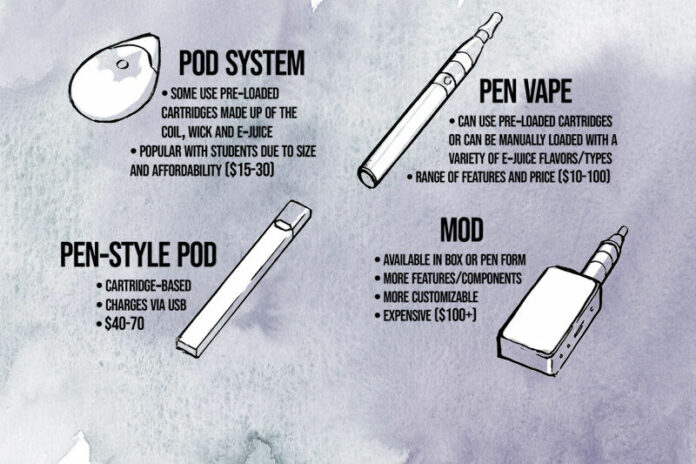In order to attempt to tackle the vast issue of underage vaping, we’ve compiled some information about how vaping works — studies that have been done on whether it’s safe, if it helps people quit, how individual devices work, as well as a glossary of terms that may prove useful when reading up on vaping.
How it works
Devices used for vaping can vary in shape, size and power — and ultimately, in name. From hand-built mods to e-cigarettes to small, badge-shaped pods, keeping track of vaping and the devices used to do it can be difficult.
Though each device has differences and some, like mods, can be customized, they all contain the same primary operating components.
“Generally a vaping device consists of a mouthpiece, a battery, a cartridge for containing the e-liquid or e-juice and a heating component for the device that is powered by a battery,” reads an article from the Center on Addiction.
The battery then heats up the heating component, usually a coil with wicks or cotton, which helps create an aerosol, oftentimes referred to as “vape.”
Some devices also contain small control displays that enable the user to control the volts, watts and/or ohms released by the device. Changing the settings can increase or decrease the power output of the device, therefore changing the vapor cloud size or e-liquid flavor intensity.
Among the other ways vaping can be customized is the nicotine amount. While e-cigarettes and mods are often used by adults who want to quit smoking — you can purchase e-liquid with varying levels of nicotine and slowly work your way down to limited amounts — when it comes to younger people, vaping often works in the opposite direction, building them up rather than taking them down.
Electronic cigarettes like the Suorin Drop, SMOK Rolo Badge or traditional vape pens have refillable cartridges, where users can put in e-liquid that they’ve purchased. Other devices like Juul or PHIX have a pod system operation, where users buy pre-made pods that contain the flavor of their choosing. While premade pods come with set nicotine milligram amounts, e-liquid can vary based on how much nicotine is diluted in the mixture being bought.
“The original design of the devices was based on that. I get the nicotine, I get the sense of smoking but I’m stepping down,” said Stacy Desideri, the principal of Windsor High School. WHS is currently working to try and combat student vaping. “The problem with that, with teenagers, is they don’t do the math and they often don’t know what’s in their device. They don’t check what they buy and what they use, so they think they are having a nicotine-free product, but then they borrow from a friend and may get a high nicotine dose.”
When it comes to the different devices that people, including teens, are using to vape, there’s been steady stream of different vaping vessels. Ariel Thomas-Urlik, health information specialist II with the Sonoma County Department of Health Services, said that she’s observed four different generations of electronic cigarettes: cigalikes, which look like traditional cigarettes but adopt an e-cig operating method and are meant to be more disposable; e-cigs, which introduced a rechargeable component; mods, which are easier to modify and began to utilize a tank system of storing liquid rather than a cartridge system; and pod-based devices, which have become more common, especially among younger people.
Since pod-based devices like the Suorin Drop or the SMOK Rolo Badge are small enough to fit in the palm of the user’s hand, they allow the user to be more discreet. Thomas-Urlik said that, when looking at students who vape, many of them favor pod-based vessels specifically because of how easy they are to use.
“They can be charged with a general USB cord, and they’re meant to be reused,” she said.
“Just in terms of devices, with youth especially … being discreet is now the trend,” said Terese Voge, health program manager for the Sonoma County Department of Health Service’s public health division. When using mod devices was more popular, many people focused on how big you could get the aerosol cloud. “Now, kids are figuring out how to be more modest and zeroing out the aerosol.”
Both Voge and Thomas-Urlik mentioned that since devices can be charged with the same cord used to charge a phone, and since they come in smaller, quirkier shapes, parents oftentimes mistake vaping devices for other things, like highlighters.
Adding to the effort to be more discreet, zeroing out is a method of “stealth vaping” that has become popular. Zeroing out involves using different methods of inhalation to limit the amount of aerosol released from a drag off a vaping device. Various websites devoted to vaping detail how to zero out, advising users to vary the lengths of their inhales and exhaling with pursed lips.
“This isn’t the same nicotine as what’s in a cigarette — it’s much more potent,” Voge said. “It’s very inviting with flavors, it doesn’t have a harsh smell, it doesn’t burn the throat.”
According to Desideri, she’s heard of similar issues popping up with people who vape THC rather than nicotine.
“At a seminar put on by the CHP, the officer said in the 80s when a person would smoke a joint, it had a 1% THC concentration, look at this label, it says, 93.6% THC,” Desideri said. “It’s like smoking 93 joints, so when we talk about smoking marijuana today we’re not talking about the same product that our generation or our parents’ generation may have interacted with … 10 years ago you might have a student who was a little high, now they are getting frighteningly high, as in maybe they need medical intervention.”
One of the most challenging aspects of underage vaping, Voge said, is the fact that people start vaping before they fully understand the risks. What starts out as a fun flavor can escalate into an addiction.
“Now that this has been happening for a while … when they go to try and stop using, it’s really challenging to quit. They get into a world they didn’t mean to get into,” Voge said.
Safer doesn’t mean safe
Is vaping safer? The answer, frustratingly, is it depends. While the aerosol vapor has less of the harmful quantities and types of chemicals found in traditional cigarettes, that doesn’t make them harmless. They also have chemicals not found in traditional cigarettes.
Studies have found that vaping can cause mouth or throat irritation, nausea and coughing. Chemicals found in different vaping products have included formaldehyde and benzene.
According to a study for National Center for Health Research (NCHR) by Brandel France de Bravo, MPH, Laura Gottschalk, Ph.D., John-Anthony Fraga and Jared Hirschfield, “a preliminary study presented at the 2018 annual meeting of the American Chemical Society found that vaping could damage DNA. The study examined the saliva of five adults before and after a 15-minute vaping session. The saliva had an increase in potentially dangerous chemicals, such as formaldehyde and acrolein. Acrolein has been proven to be associated with DNA damage, for example, and DNA damage can eventually cause cancer.”
A National Institutes of Health study on mice found an increase in the genetic mutations associated with lung and bladder cancer in animals exposed to the vapor.
It’s also, according to current research, not a known quantity yet, due the youth of the technology.
“Cancer takes years to develop, and e-cigarettes were only very recently introduced to the United States. It is almost impossible to determine if a product increases a person’s risk of cancer or not until the product has been around for at least 15 to 20 years,” said the NCHR study.
“We know cigarettes cause lung cancer, we know (chewing tobacco) carries an increased risk of mouth cancer,” said Desideri. “We know because we researched, we have long-term studies about the effects. We only have 10 years of research on these devices. They are seeing significant impacts in immune systems, mouth sores, popcorn lung, aspiration issues and blisters inside lungs. The long-term effects of the chemicals in these have not been studied and they just don’t know the effects of the inhalants like glycerin and the other chemicals they use for transport. They just don’t know and again, because vaping is safer, to (teens) it means safe, and that’s scary. Because it’s a big risk.”
There is also uncertainty as to whether vaping is safer for second-hand ingesters. A study published in the International Journal of Hygiene and Environmental Health found that the use of e-cigarettes results in increased concentrations of volatile organic compounds (VOCs) and airborne particles, both of which are potentially harmful when inhaled.
However, research also shows that the effect of these exposures is significantly greater for teen users. Multiple studies in the U.S. and abroad have shown the nicotine exposure is harmful to the developing brain of anyone under the age of 25, and has shown to interfere with both memory and attention processing.
“Exposing a developing brain to an addictive drug such as nicotine can potentially lead to permanent alterations in brain chemistry,” according to a study at the Mayo Clinic. “That can disrupt the growth of connections within the brain that control learning and attention. It also may make the brain more vulnerable to other forms of addiction in the future.”
There are also dangers to just handling the devices.
“I always wear gloves,” said Desideri. “The oils with nicotine are skin soluble, and I have had a moment or two when I’ve had to handle a device, and my skin gets tingly, and I know it’s getting into my system; and I never know exactly what’s in it. It might be a high-octane nicotine, and I don’t ever want to take that risk, and I don’t want my staff to either. I insist we all wear gloves when do searches and when anyone forgets I give reminders. Every teacher has a box of gloves for protection,” she said.
She also had the experience of seeing the dangers and instability of the devices when she took her stash home on a weekend to clean them for demonstration purposes. She soaked the devices in soapy water for several hours and then put them outside on her unlit barbecue to dry, and several started to smoke and catch fire.
“I got very nervous and left them outside for 48 hours,” she said.
Finally, there are also increased risks to small children who may accidently come into contact with vaping products. The liquid is highly concentrated, so absorbing it through the skin or swallowing it is far more likely to require an emergency room visit than eating or swallowing regular cigarettes. In 2012, less than 50 kids under the age of 6 were reported to poison control hotlines per month because of e-cigarettes. In 2015, that number had skyrocketed to about 200 children a month, almost half of which were under the age of 2.
And none of this addresses the simple fact that nicotine is a highly addictive compound, creating a high degree of dependency in the user, and damning teens who start vaping to a long-term struggle with addiction.
Studies show people who try vaping under the age of 18 are three-and-a-half times as likely to eventually end up smoking regular cigarettes. The easiest way to quit is to not become addicted in the first place.
Does vaping help you quit?
This is where the science gets complicated. Because the answer is both yes and no.
Some of the initial marketing of e-cigarettes touted their utility in smoking cessation. The idea was that if you were a current, regular smoker, you started with a high percentage of nicotine, and then stepped down over time so that eventually you were smoking nicotine-free juice. In addition to the non-cold-turkey approach, it also allowed smokers to indulge their oral fixation.
Studies performed comparing e-cigarette use to other smoking cessation products showed that it was nearly twice as likely to be effective.
According to a study by published in the New England Journal of Medicine, 900 people who wanted to quit smoking were randomly assigned either e-cigarettes or other nicotine replacement products (such as nicotine patches and gum). Study participants received additional counseling every week for four weeks. After a year, a measure of exhaled carbon monoxide confirmed who had in fact stopped smoking.
Researchers found that while approximately twice as many people assigned to vape had successfully stopped smoking as compared to the other methods, the number of people who had successfully stopped smoking was very small — in the vaping group, the number was around 18%, while in the other therapies group, the number was only 10%.
39.5
F
Healdsburg
March 10, 2025








